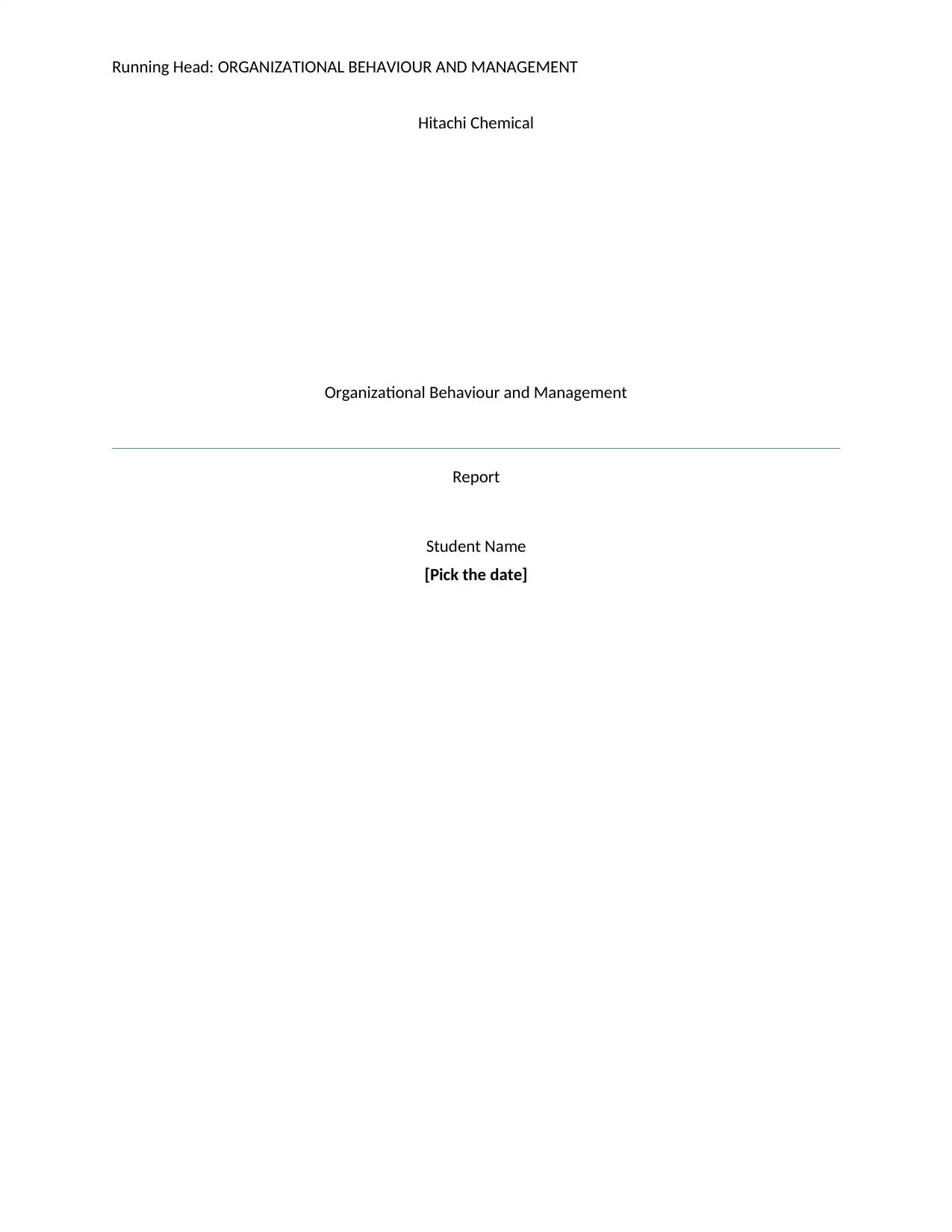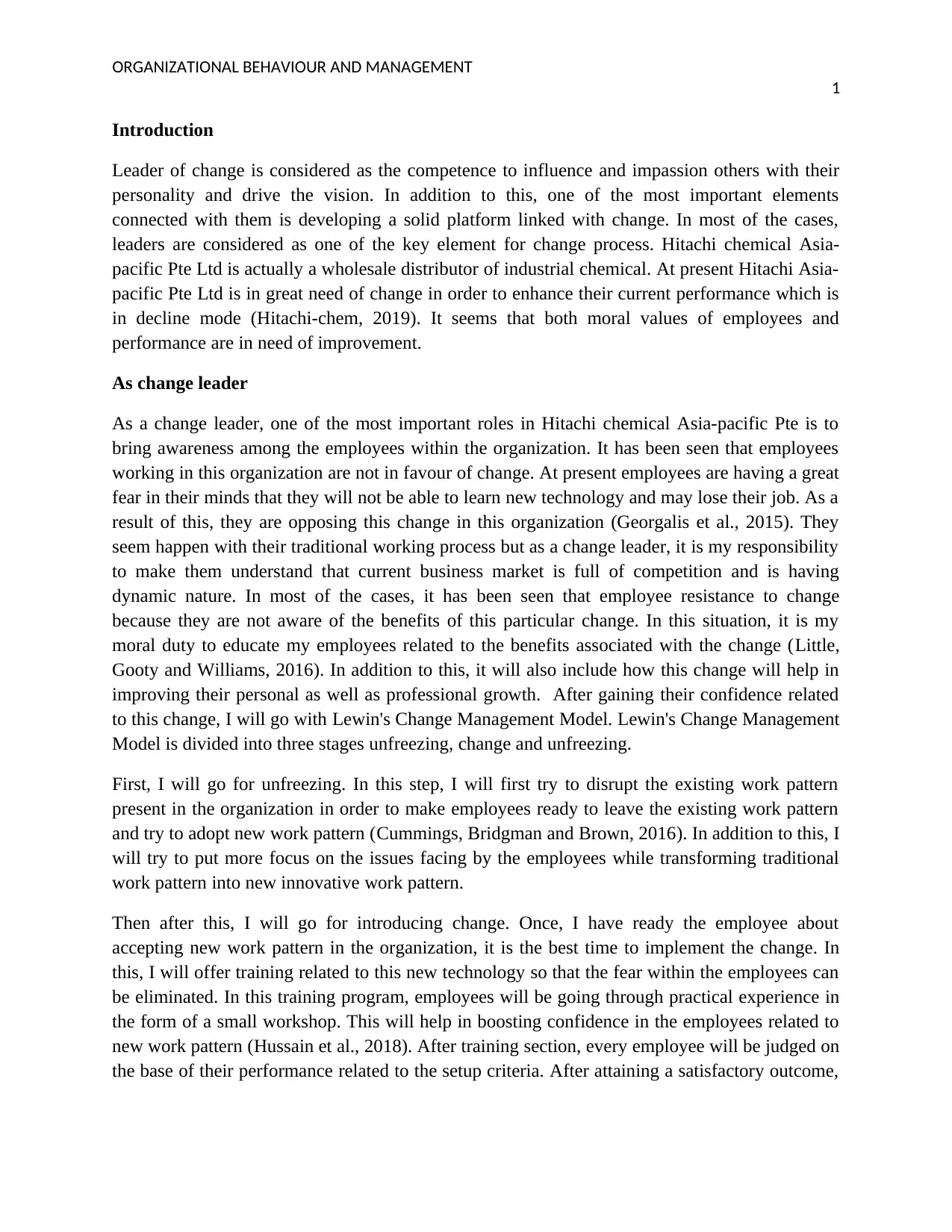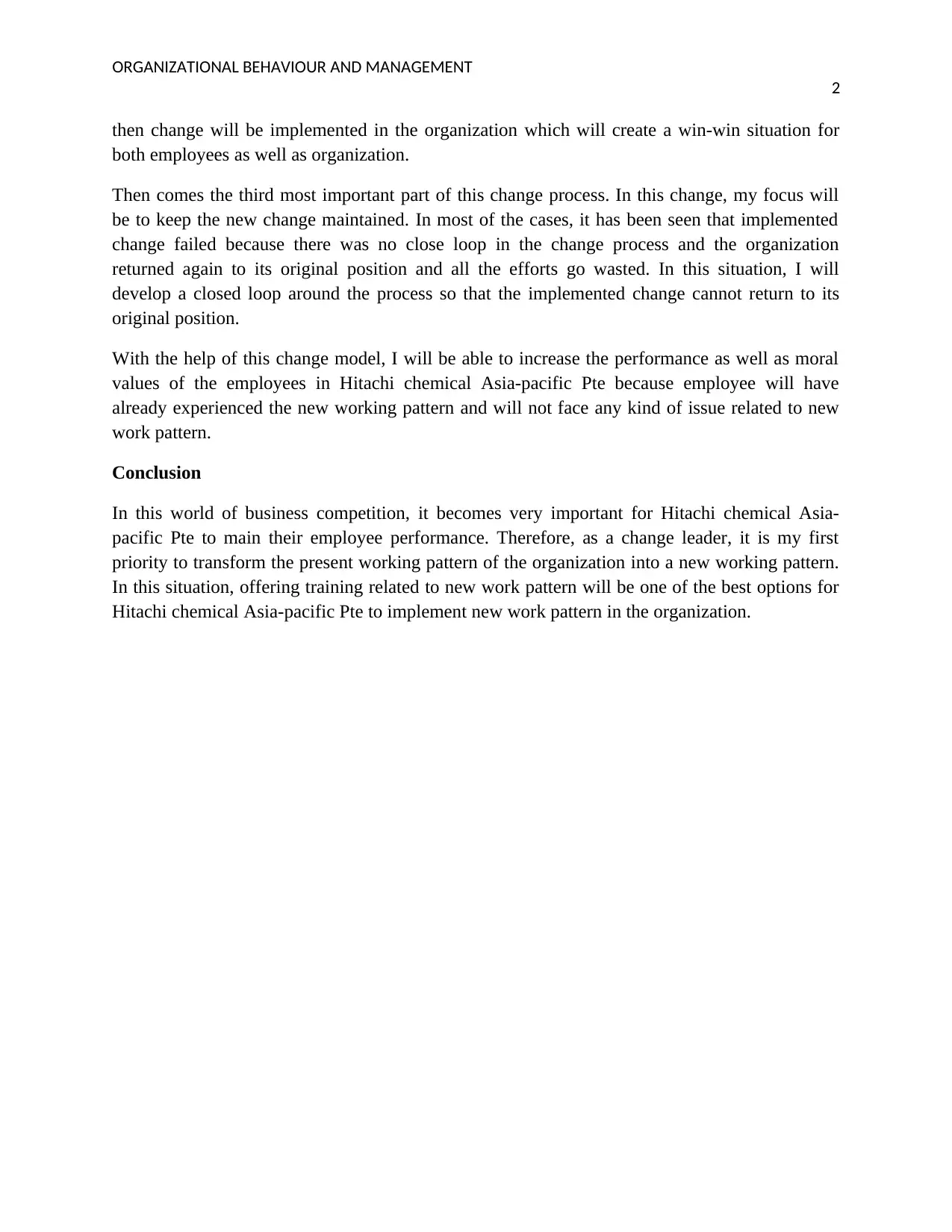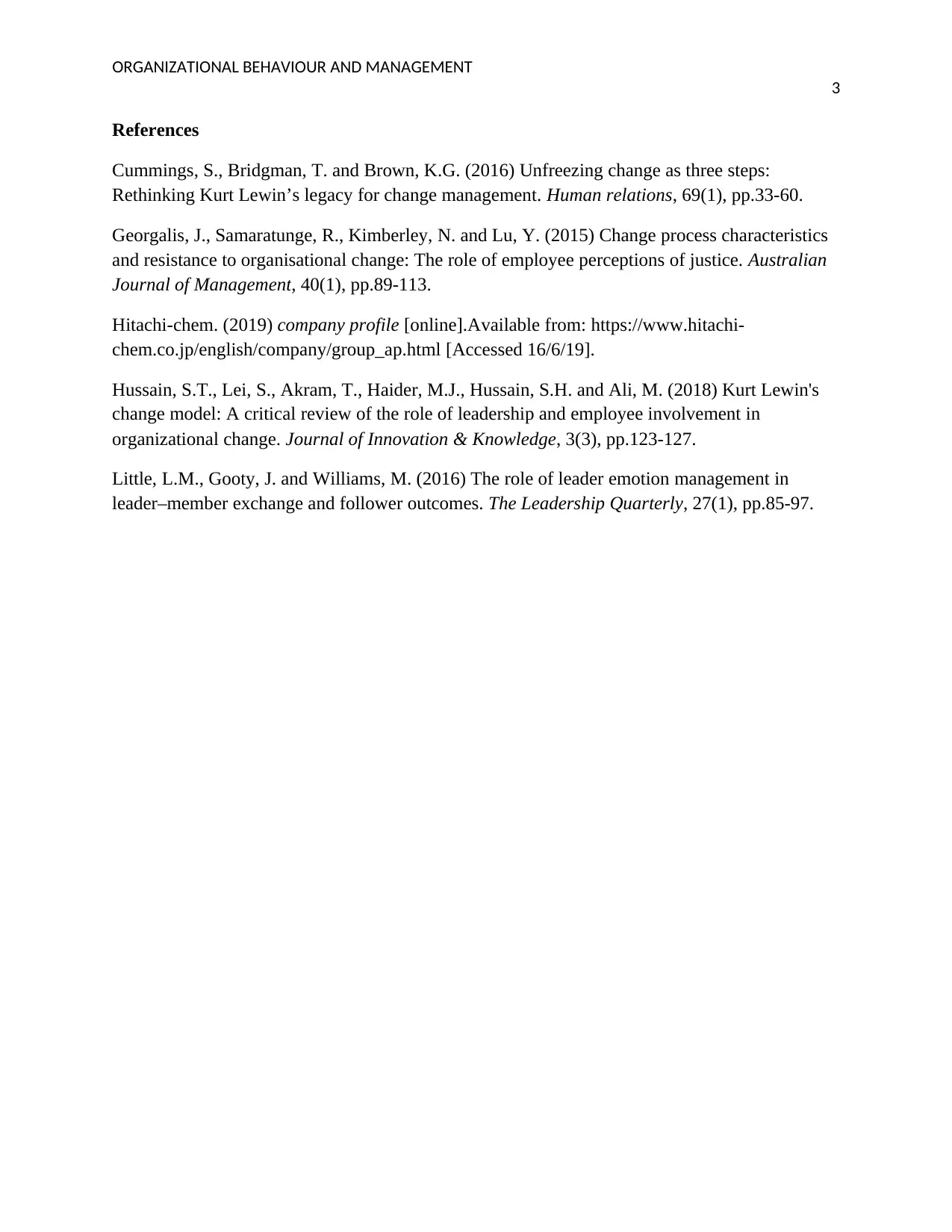Change Leadership Strategies for Hitachi Chemical Asia-Pacific Pte Ltd
VerifiedAdded on 2022/12/20
|4
|1074
|66
Report
AI Summary
This report focuses on change leadership within Hitachi Chemical Asia-Pacific Pte Ltd, addressing the company's need for organizational change to improve performance and employee morale. The report emphasizes the role of a change leader in raising employee awareness and overcoming resistance to change, particularly regarding the adoption of new technologies. It details the application of Lewin's Change Management Model, including unfreezing, change implementation through training, and refreezing to sustain the changes. The report highlights the importance of employee training and creating a closed-loop system to prevent a return to the original working patterns. The goal is to enhance employee performance and morale through effective change management strategies.

Running Head: ORGANIZATIONAL BEHAVIOUR AND MANAGEMENT
Hitachi Chemical
Organizational Behaviour and Management
Report
Student Name
[Pick the date]
Hitachi Chemical
Organizational Behaviour and Management
Report
Student Name
[Pick the date]
Paraphrase This Document
Need a fresh take? Get an instant paraphrase of this document with our AI Paraphraser

ORGANIZATIONAL BEHAVIOUR AND MANAGEMENT
1
Introduction
Leader of change is considered as the competence to influence and impassion others with their
personality and drive the vision. In addition to this, one of the most important elements
connected with them is developing a solid platform linked with change. In most of the cases,
leaders are considered as one of the key element for change process. Hitachi chemical Asia-
pacific Pte Ltd is actually a wholesale distributor of industrial chemical. At present Hitachi Asia-
pacific Pte Ltd is in great need of change in order to enhance their current performance which is
in decline mode (Hitachi-chem, 2019). It seems that both moral values of employees and
performance are in need of improvement.
As change leader
As a change leader, one of the most important roles in Hitachi chemical Asia-pacific Pte is to
bring awareness among the employees within the organization. It has been seen that employees
working in this organization are not in favour of change. At present employees are having a great
fear in their minds that they will not be able to learn new technology and may lose their job. As a
result of this, they are opposing this change in this organization (Georgalis et al., 2015). They
seem happen with their traditional working process but as a change leader, it is my responsibility
to make them understand that current business market is full of competition and is having
dynamic nature. In most of the cases, it has been seen that employee resistance to change
because they are not aware of the benefits of this particular change. In this situation, it is my
moral duty to educate my employees related to the benefits associated with the change (Little,
Gooty and Williams, 2016). In addition to this, it will also include how this change will help in
improving their personal as well as professional growth. After gaining their confidence related
to this change, I will go with Lewin's Change Management Model. Lewin's Change Management
Model is divided into three stages unfreezing, change and unfreezing.
First, I will go for unfreezing. In this step, I will first try to disrupt the existing work pattern
present in the organization in order to make employees ready to leave the existing work pattern
and try to adopt new work pattern (Cummings, Bridgman and Brown, 2016). In addition to this, I
will try to put more focus on the issues facing by the employees while transforming traditional
work pattern into new innovative work pattern.
Then after this, I will go for introducing change. Once, I have ready the employee about
accepting new work pattern in the organization, it is the best time to implement the change. In
this, I will offer training related to this new technology so that the fear within the employees can
be eliminated. In this training program, employees will be going through practical experience in
the form of a small workshop. This will help in boosting confidence in the employees related to
new work pattern (Hussain et al., 2018). After training section, every employee will be judged on
the base of their performance related to the setup criteria. After attaining a satisfactory outcome,
1
Introduction
Leader of change is considered as the competence to influence and impassion others with their
personality and drive the vision. In addition to this, one of the most important elements
connected with them is developing a solid platform linked with change. In most of the cases,
leaders are considered as one of the key element for change process. Hitachi chemical Asia-
pacific Pte Ltd is actually a wholesale distributor of industrial chemical. At present Hitachi Asia-
pacific Pte Ltd is in great need of change in order to enhance their current performance which is
in decline mode (Hitachi-chem, 2019). It seems that both moral values of employees and
performance are in need of improvement.
As change leader
As a change leader, one of the most important roles in Hitachi chemical Asia-pacific Pte is to
bring awareness among the employees within the organization. It has been seen that employees
working in this organization are not in favour of change. At present employees are having a great
fear in their minds that they will not be able to learn new technology and may lose their job. As a
result of this, they are opposing this change in this organization (Georgalis et al., 2015). They
seem happen with their traditional working process but as a change leader, it is my responsibility
to make them understand that current business market is full of competition and is having
dynamic nature. In most of the cases, it has been seen that employee resistance to change
because they are not aware of the benefits of this particular change. In this situation, it is my
moral duty to educate my employees related to the benefits associated with the change (Little,
Gooty and Williams, 2016). In addition to this, it will also include how this change will help in
improving their personal as well as professional growth. After gaining their confidence related
to this change, I will go with Lewin's Change Management Model. Lewin's Change Management
Model is divided into three stages unfreezing, change and unfreezing.
First, I will go for unfreezing. In this step, I will first try to disrupt the existing work pattern
present in the organization in order to make employees ready to leave the existing work pattern
and try to adopt new work pattern (Cummings, Bridgman and Brown, 2016). In addition to this, I
will try to put more focus on the issues facing by the employees while transforming traditional
work pattern into new innovative work pattern.
Then after this, I will go for introducing change. Once, I have ready the employee about
accepting new work pattern in the organization, it is the best time to implement the change. In
this, I will offer training related to this new technology so that the fear within the employees can
be eliminated. In this training program, employees will be going through practical experience in
the form of a small workshop. This will help in boosting confidence in the employees related to
new work pattern (Hussain et al., 2018). After training section, every employee will be judged on
the base of their performance related to the setup criteria. After attaining a satisfactory outcome,

ORGANIZATIONAL BEHAVIOUR AND MANAGEMENT
2
then change will be implemented in the organization which will create a win-win situation for
both employees as well as organization.
Then comes the third most important part of this change process. In this change, my focus will
be to keep the new change maintained. In most of the cases, it has been seen that implemented
change failed because there was no close loop in the change process and the organization
returned again to its original position and all the efforts go wasted. In this situation, I will
develop a closed loop around the process so that the implemented change cannot return to its
original position.
With the help of this change model, I will be able to increase the performance as well as moral
values of the employees in Hitachi chemical Asia-pacific Pte because employee will have
already experienced the new working pattern and will not face any kind of issue related to new
work pattern.
Conclusion
In this world of business competition, it becomes very important for Hitachi chemical Asia-
pacific Pte to main their employee performance. Therefore, as a change leader, it is my first
priority to transform the present working pattern of the organization into a new working pattern.
In this situation, offering training related to new work pattern will be one of the best options for
Hitachi chemical Asia-pacific Pte to implement new work pattern in the organization.
2
then change will be implemented in the organization which will create a win-win situation for
both employees as well as organization.
Then comes the third most important part of this change process. In this change, my focus will
be to keep the new change maintained. In most of the cases, it has been seen that implemented
change failed because there was no close loop in the change process and the organization
returned again to its original position and all the efforts go wasted. In this situation, I will
develop a closed loop around the process so that the implemented change cannot return to its
original position.
With the help of this change model, I will be able to increase the performance as well as moral
values of the employees in Hitachi chemical Asia-pacific Pte because employee will have
already experienced the new working pattern and will not face any kind of issue related to new
work pattern.
Conclusion
In this world of business competition, it becomes very important for Hitachi chemical Asia-
pacific Pte to main their employee performance. Therefore, as a change leader, it is my first
priority to transform the present working pattern of the organization into a new working pattern.
In this situation, offering training related to new work pattern will be one of the best options for
Hitachi chemical Asia-pacific Pte to implement new work pattern in the organization.
⊘ This is a preview!⊘
Do you want full access?
Subscribe today to unlock all pages.

Trusted by 1+ million students worldwide

ORGANIZATIONAL BEHAVIOUR AND MANAGEMENT
3
References
Cummings, S., Bridgman, T. and Brown, K.G. (2016) Unfreezing change as three steps:
Rethinking Kurt Lewin’s legacy for change management. Human relations, 69(1), pp.33-60.
Georgalis, J., Samaratunge, R., Kimberley, N. and Lu, Y. (2015) Change process characteristics
and resistance to organisational change: The role of employee perceptions of justice. Australian
Journal of Management, 40(1), pp.89-113.
Hitachi-chem. (2019) company profile [online].Available from: https://www.hitachi-
chem.co.jp/english/company/group_ap.html [Accessed 16/6/19].
Hussain, S.T., Lei, S., Akram, T., Haider, M.J., Hussain, S.H. and Ali, M. (2018) Kurt Lewin's
change model: A critical review of the role of leadership and employee involvement in
organizational change. Journal of Innovation & Knowledge, 3(3), pp.123-127.
Little, L.M., Gooty, J. and Williams, M. (2016) The role of leader emotion management in
leader–member exchange and follower outcomes. The Leadership Quarterly, 27(1), pp.85-97.
3
References
Cummings, S., Bridgman, T. and Brown, K.G. (2016) Unfreezing change as three steps:
Rethinking Kurt Lewin’s legacy for change management. Human relations, 69(1), pp.33-60.
Georgalis, J., Samaratunge, R., Kimberley, N. and Lu, Y. (2015) Change process characteristics
and resistance to organisational change: The role of employee perceptions of justice. Australian
Journal of Management, 40(1), pp.89-113.
Hitachi-chem. (2019) company profile [online].Available from: https://www.hitachi-
chem.co.jp/english/company/group_ap.html [Accessed 16/6/19].
Hussain, S.T., Lei, S., Akram, T., Haider, M.J., Hussain, S.H. and Ali, M. (2018) Kurt Lewin's
change model: A critical review of the role of leadership and employee involvement in
organizational change. Journal of Innovation & Knowledge, 3(3), pp.123-127.
Little, L.M., Gooty, J. and Williams, M. (2016) The role of leader emotion management in
leader–member exchange and follower outcomes. The Leadership Quarterly, 27(1), pp.85-97.
1 out of 4
Related Documents
Your All-in-One AI-Powered Toolkit for Academic Success.
+13062052269
info@desklib.com
Available 24*7 on WhatsApp / Email
![[object Object]](/_next/static/media/star-bottom.7253800d.svg)
Unlock your academic potential
Copyright © 2020–2025 A2Z Services. All Rights Reserved. Developed and managed by ZUCOL.





